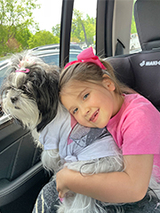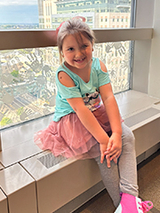Natalie’s Story: Novel Treatment of Aicardi Goutieres Syndrome
Natalie’s Story: Novel Treatment of Aicardi Goutieres Syndrome
Natalie could walk, talk, and was ahead of all milestones for her age. Then, when she was 18 months old, her parents, Nicole and Patrick, noticed her lifting her big toes off the ground when she walked, as though she had a splinter or cut on the bottom of her foot. Her knees also started buckling when she walked.

The family’s pediatrician examined Natalie’s gait and thought it was likely a temporary issue that would resolve on its own in time.
But rather than resolve, Natalie’s walking issue worsened. At a second appointment, the pediatrician did a broader examination. When she was unable to bend Natalie’s arm at the elbow, the pediatrician grew concerned. She sent the family to the emergency room immediately.
The search for answers leads to leukodystrophy

The ER visit led to a CT scan and MRI, both of which showed abnormalities in the white matter of Natalie’s brain. A neurologist at the hospital suspected Natalie had an autoimmune disorder known as acute disseminated encephalomyelitis (ADEM).
Over the next month, Natalie was admitted to the hospital on two separate occasions. Each time, she underwent a 10-day course of steroids and intravenous immunoglobulin (IVIG). Despite these treatments, her neurologic function and developmental skills continued to decline.
Patrick researched ADEM online and found a neurologist at Boston Children’s Hospital that specializes in the condition. Based on Natalie’s medical records and brain scans, the neurologist didn’t think she had ADEM. He ran a rapid whole exome sequencing test, which confirmed his suspicion and her diagnosis. The test came back positive for Aicardi-Goutières syndrome (AGS).
AGS is a rare genetic disorder and type of leukodystrophy that affects the brain, spinal cord and immune system. In patients with AGS, the body’s immune system turns on itself in a destructive way, targeting the brain’s white matter, causing most children with the disorder to experience mild to severe intellectual or physical impairments. Most children with AGS are unable to walk or talk and have multisystemic complications, including skin inflammation and injury to the liver, lungs, heart, and other organs.
Timing aligns for trial of novel treatment

At the time of Natalie’s diagnosis, she could barely open her mouth or extend her arms, she couldn’t use her hands, and her legs were so stiff that she was pretty much bed ridden. The neurologist at Boston Children’s knew Adeline Vanderver, MD, Program Director of the Leukodystrophy Center at Children’s Hospital of Philadelphia (CHOP), was currently enrolling patients in a Phase II clinical trial to investigate the safety and efficacy of baricitinib, a Janus kinase (JAK) inhibitor thought to potentially alleviate the inflammatory symptoms associated with AGS. He connected with Dr. Vanderver and, thanks to a truly collaborative effort between clinicians and researchers at CHOP and Boston Children’s Hospital, Natalie was enrolled in the trial within a very short timeframe.
Literally hours after taking the medicine, the muscles in Natalie’s face started working again.
“As she was taking this medicine, we could see drastic changes,” says Patrick. “Without this medication, she would’ve continued to decline for the next month or two and she would be in a far worse situation than she’s in now.”
Natalie was admitted to CHOP for three weeks of inpatient rehabilitation at the start of the clinical trial. When she was discharged back home to Alabama, she could smile again and her arm mobility had greatly improved. Soon thereafter, she regained the ability to crawl. She’s continued to see mobility gains to this day, and is no longer bed ridden.
“She thinks every day is the best day,” says Patrick, who describes Natalie as smart, funny and witty. “Despite the unfortunate challenges that AGS has dealt her, she’s got a better attitude than anyone I come in contact with on a daily basis. Natalie just lives for the day and loves every minute of it.”
CHOP’s clinical trial of baricitinib ended in 2018, but Natalie has continued taking the medication. Despite the family’s distance from Philadelphia, they have kept Natalie’s neurology care with Dr. Vanderver’s team, and they return twice a year for follow-up appointments.
“They are her doctors, they saw her at her worst,” says Patrick of the CHOP team.
“If I met someone who said their child has AGS, I’d say get to CHOP. I want them to continue seeing her because they’re going to have the most knowledge of where future advancement are heading or what to do if we have a problem going on. That’s why we see them.”